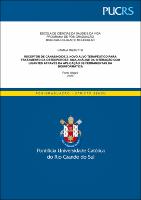| Share record |


|
Please use this identifier to cite or link to this item:
https://tede2.pucrs.br/tede2/handle/tede/9884| Document type: | Dissertação |
| Title: | Receptor de Canabinoide 2. novo alvo terapêutico para tratamento da osteoporose : uma análise da interação com ligantes através da aplicação de ferramentas da bioinformática |
| Author: | Rizzotto, Camila  |
| Advisor: | Azevedo Junior, Walter Filgueira de |
| Abstract (native): | Os receptores canabinoide estão amplamente distribuídos nos tecidos animais e são classificados como tipos 1 e 2. Sabe-se que estes receptores são responsáveis por inúmeras funções nos tecidos saudáveis e tem sua estrutura preservada ao longo do tempo e das espécies. O receptor canabinoide 1, que recentemente teve sua estrutura resolvida por cristalografia de difração de raios-x, está presente em grande parte no sistema nervoso central - sendo responsável por funções como controle do gasto energético, da memória e do aprendizado. Sabemos também do seu papel em várias desordens dos sistemas como nas manifestações de dor crônica, epilepsia e outras doenças neurodegenerativas. Apesar de também presente no sistema nervoso central, o receptor canabinoide 2 é mais frequente no tecido hematopoético e no sistema imune, sendo responsável pelo controle de alguns processos relacionados ao metabolismo ósseo e no controle de rotas da atividade inflamatória do organismo. Ambos receptores pertencem à família de receptores ligados à proteína G em um sistema amplamente estudado e hoje conhecido como sistema endocanabinoide. O uso de ferramentas da bioinformática ajuda a elucidar alvos terapêuticos para controle da expressão destes receptores visando sanar algumas carências nos tratamentos de doenças crônicas complexas. Recentemente a estrutura cristalográfica do Receptor Canabinoide 1 foi resolvida com elevada resolução. Por ser um receptor de membrana existem dificuldades intrínsecas para determinação estrutural desta proteína. Em um curto período foram disponibilizadas na base de dados do Protein Data Bank duas estruturas do receptor ligadas à agonistas e outras duas ligadas à antagonistas. Mais recentemente foi resolvida a estrutura tridimensional do Receptor de canabinoide tipo 2 e esse avanço abriu espaço para, com certa segurança, termos usado a estrutura resolvida para achar as cavidades ativas da proteína para docagem e determinação de possíveis alvos terapêuticos para tratamento das doenças osteometabólicas, como a osteoporose, e das doenças inflamatórias crônicas. Visamos o uso da metodologia computacional na identificação de sítios de ligação da proteína e uso de docagem para teste de pequenas moléculas como agonistas e antagonistas do receptor. Foram usadas abordagens de docking molecular e o aprendizado de máquina para investigarmos as interações proteína-ligante. |
| Abstract (english): | Cannabinoid receptors are widely distributed in animal tissues and are classified as types 1 and 2. It is known that these receptors are responsible for numerous functions in healthy tissues and their structure is preserved over time and species. The cannabinoid receptor 1, which recently had its structure resolved by Xray diffraction crystallography, is present largely in the central nervous system - being responsible for functions such as managing energy expenditure, memory and learning. We are also aware of its role in various disorders of the systems such as the manifestations of chronic pain, epilepsy and neurodegenerative diseases. Although also present in the central nervous system, the cannabinoid receptor 2 is more frequently found in hematopoietic tissue and in the immune system, being responsible for controlling some of the processes related to bone metabolism and in routes of inflammatory activity. Both receptors belong to the family of receptors linked to the G protein in a widely studied system and today known as the endocannabinoid system. The use of bioinformatics tools helps to elucidate therapeutic targets to control the expression of these receptors in order to solve some deficiencies in the treatment of complex chronic diseases. Recently, the crystallographic structure of the Cannabinoid Receptor 1 was resolved with high resolution. Because it is a membrane receptor, there are intrinsic difficulties for structural determination of this protein. In a short period, two structures of the receptor linked to agonists and two others linked to antagonists were made available in the Protein Data Bank database. Most recently, the three-dimensional structure of the type 2 cannabinoid receptor has been resolved and this advance made room for, with some certainty, the use of resolved structure to find the active protein cavities for docking and determining possible therapeutic targets for the treatment of osteometabolic diseases, like osteoporosis, and chronic inflammatory diseases. We used a computational methodology to identify protein binding sites and docking to test small molecules as receptor agonists and antagonists. Molecular docking approaches and machine learning were used to investigate protein-ligand interactions and to create a proteinspecific score function to accurately predict other possible interactions should they be evaluated in the future. |
| Keywords: | Receptor Canabinoide 1 Canabinoide 2 Docagem GCPR CB1 CB2 CNR1 CNR2 Osteoporose |
| CNPQ Knowledge Areas: | CIENCIAS BIOLOGICAS::BIOLOGIA GERAL |
| Language: | por |
| Country: | Brasil |
| Publisher: | Pontifícia Universidade Católica do Rio Grande do Sul |
| Institution Acronym: | PUCRS |
| Department: | Escola de Ciências |
| Program: | Programa de Pós-Graduação em Biologia Celular e Molecular |
| Access type: | Acesso Aberto |
| Fulltext access restriction: | Trabalho não apresenta restrição para publicação |
| URI: | http://tede2.pucrs.br/tede2/handle/tede/9884 |
| Issue Date: | 31-Mar-2020 |
| Appears in Collections: | Programa de Pós-Graduação em Biologia Celular e Molecular |
Files in This Item:
| File | Description | Size | Format | |
|---|---|---|---|---|
| CAMILA_RIZZOTTO_DIS.pdf | CAMILA_RIZZOTTO_DIS | 10.79 MB | Adobe PDF |  Download/Open Preview |
Items in DSpace are protected by copyright, with all rights reserved, unless otherwise indicated.




